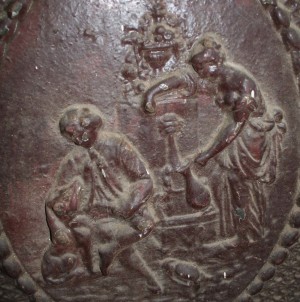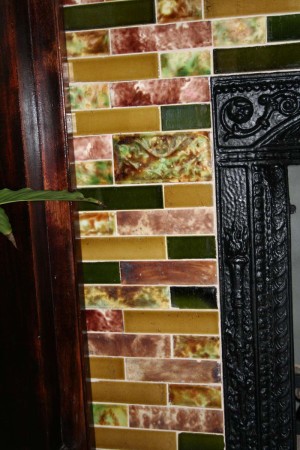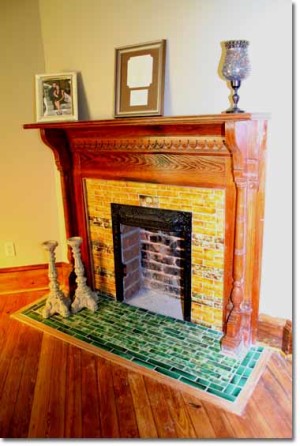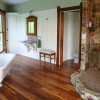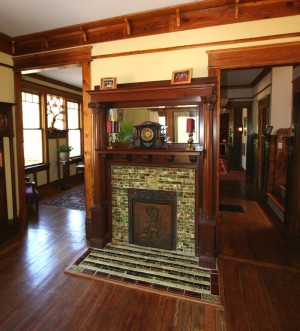 There are certain restoration projects that are less construction and more art. Those are by far the most work and challenge and by far the most rewarding. Kitchens and baths naturally lend themselves to that definition simply because they mix the most media: tile, wood, color, flooring, appliances, ceiling treatment, glass (stained, reclaimed, art, iridescent, or clear), countertop surface, hardware doors, and fixtures.
There are certain restoration projects that are less construction and more art. Those are by far the most work and challenge and by far the most rewarding. Kitchens and baths naturally lend themselves to that definition simply because they mix the most media: tile, wood, color, flooring, appliances, ceiling treatment, glass (stained, reclaimed, art, iridescent, or clear), countertop surface, hardware doors, and fixtures.
Of course all the rooms of a house can be creatively enhanced. But fireplaces are another area where the creative muscle can be easily flexed.
The typical fireplace we restore is either the Victorian hearth or the Craftsman. I’ve also worked on Tudor fireplaces, stone fireplaces, rustic fireplaces, and recently a mid-century modern. But for a moment, let’s talk about the 100 year-old plus fireplace.
First, when originally installed, the hearth was a necessary focal point in the room. Typically coal burning, these hearths were a primary heat source, as well as a way to show off some gorgeous woodwork, cast iron detailing in a surround, and encaustic tile. Let’s look at the parts in closer detail.
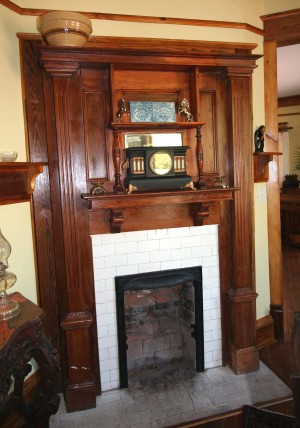 Mantel Pieces: Early federal era mantels were large and simple. Fireplaces were wood-burning and the openings huge. Industrialization brought a hotter flame and coal as well as Victorian factories and ornate woodworking and showy carving, turned columns, gingerbread accents, and everything to flaunt the focal point of the room. Beveled large mirrors were often inserted in the over-mantel to brighten the room.
Mantel Pieces: Early federal era mantels were large and simple. Fireplaces were wood-burning and the openings huge. Industrialization brought a hotter flame and coal as well as Victorian factories and ornate woodworking and showy carving, turned columns, gingerbread accents, and everything to flaunt the focal point of the room. Beveled large mirrors were often inserted in the over-mantel to brighten the room.
Craftsman mantels continued the rich wood grain tradition. Although the lines were simplified and often squared off. However, there are still the more ornate Craftsman mantel piece carved from quarter-sawn oak with leaded glass and cabinets assimilated into them.
Any genre can kick the mantel into the next level, often the stratosphere.
Cast Iron Surround & Summer Screen:
This functional piece of metal wraps the brick interior of the hearth and segues between the tile work and the brick sides. It’s a resilient material, usually an iron amalgam, and can handle the obvious heat and be a buffer between the flames, intense heat, and tile itself. Like most things house related, you can find very simple surrounds featuring no ornamentation and fancy Victorian piece with fleur de lys and ivy and cherubs. Some are rounded and some are simple and have 90 degree angled corners.
Summer screens flow along the same lines, but summer screens are much rarer. Over decades, homeowners or tenants lost them or threw them away since they weren’t built into the fireplace. And they often featured pastoral scenes of deer, floral motifs, or people playing lutes and mandolins. Sometimes they featured Greek figures or romantic figures.
Tile:
Tile is one of my favorite media. When I began renovating, I was a newbie to antique fireplace tile. There was an old Craftsman fireplace in the Oakhurst neighborhood of Atlanta we were restoring. It was a gorgeous home with coffered ceilings and original oak mantels and fireplace tile. We were missing about eight “brown” tiles. The internet and local hardware stores yielded nothing that resembled this flat matte, mottled brownish tile.
So I went to Callanwolde, an artsy place and found a potter. She rather laughed when I said my 1 inch x 6 inch tile was brown and explained patiently that it was an encaustic tile with multiple layers of glaze and multiple kiln firings. $300 later, we had our eight replacement tiles and she had to create twice that many to get them not to shrink in the kiln. They were a very close match and went perfectly in the restoration. It was well worth it for the perfection and gloriousness that was that fireplace restored.
And like mantel and surrounds, tile comes in a vast array of diversity. There is simple tile, all colors of the rainbows, most in the 1×6 inch size. But I’ve had Turkish tile, and larger tiles, some 2x and some 3x. I’ve even had some giant encaustic tiles and some sculpted with Greek faces and some with fleur de lys and ivy and flowers and such.
Basically, it’s all art and combining it is art as well. Anytime I get a fireplace restoration job, I’m excited because it’s an art project and I’m creating the focal point of someone’s room.
